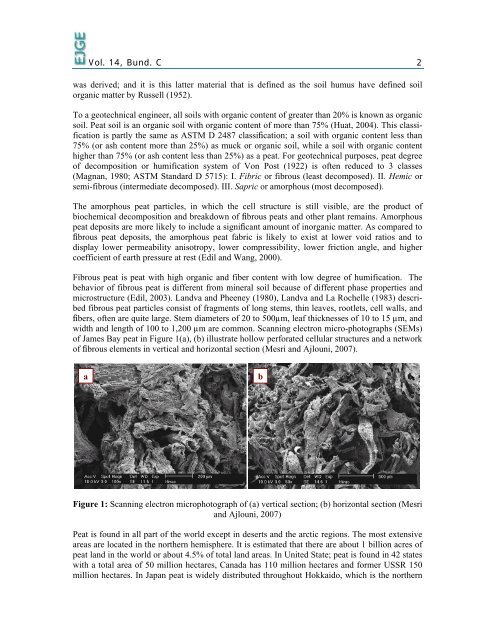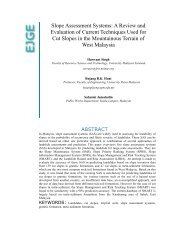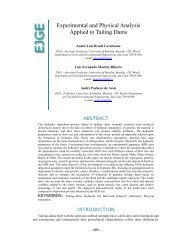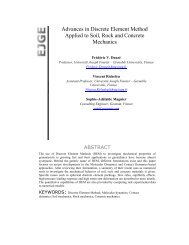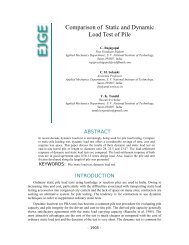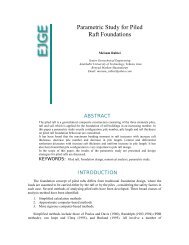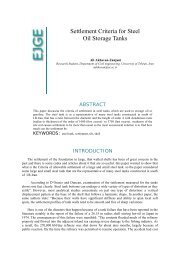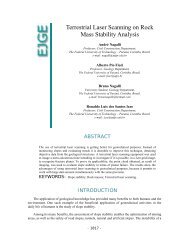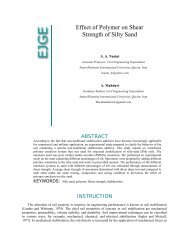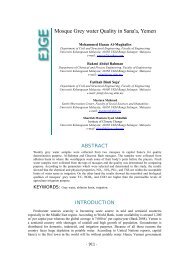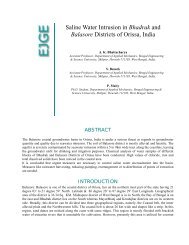Compressibility Characteristics of Fibrous Tropical Peat ... - Ejge.com
Compressibility Characteristics of Fibrous Tropical Peat ... - Ejge.com
Compressibility Characteristics of Fibrous Tropical Peat ... - Ejge.com
You also want an ePaper? Increase the reach of your titles
YUMPU automatically turns print PDFs into web optimized ePapers that Google loves.
Vol. 14, Bund. C 2<br />
was derived; and it is this latter material that is defined as the soil humus have defined soil<br />
organic matter by Russell (1952).<br />
To a geotechnical engineer, all soils with organic content <strong>of</strong> greater than 20% is known as organic<br />
soil. <strong>Peat</strong> soil is an organic soil with organic content <strong>of</strong> more than 75% (Huat, 2004). This classification<br />
is partly the same as ASTM D 2487 classification; a soil with organic content less than<br />
75% (or ash content more than 25%) as muck or organic soil, while a soil with organic content<br />
higher than 75% (or ash content less than 25%) as a peat. For geotechnical purposes, peat degree<br />
<strong>of</strong> de<strong>com</strong>position or humification system <strong>of</strong> Von Post (1922) is <strong>of</strong>ten reduced to 3 classes<br />
(Magnan, 1980; ASTM Standard D 5715): I. Fibric or fibrous (least de<strong>com</strong>posed). II. Hemic or<br />
semi-fibrous (intermediate de<strong>com</strong>posed). III. Sapric or amorphous (most de<strong>com</strong>posed).<br />
The amorphous peat particles, in which the cell structure is still visible, are the product <strong>of</strong><br />
biochemical de<strong>com</strong>position and breakdown <strong>of</strong> fibrous peats and other plant remains. Amorphous<br />
peat deposits are more likely to include a significant amount <strong>of</strong> inorganic matter. As <strong>com</strong>pared to<br />
fibrous peat deposits, the amorphous peat fabric is likely to exist at lower void ratios and to<br />
display lower permeability anisotropy, lower <strong>com</strong>pressibility, lower friction angle, and higher<br />
coefficient <strong>of</strong> earth pressure at rest (Edil and Wang, 2000).<br />
<strong>Fibrous</strong> peat is peat with high organic and fiber content with low degree <strong>of</strong> humification. The<br />
behavior <strong>of</strong> fibrous peat is different from mineral soil because <strong>of</strong> different phase properties and<br />
microstructure (Edil, 2003). Landva and Pheeney (1980), Landva and La Rochelle (1983) described<br />
fibrous peat particles consist <strong>of</strong> fragments <strong>of</strong> long stems, thin leaves, rootlets, cell walls, and<br />
fibers, <strong>of</strong>ten are quite large. Stem diameters <strong>of</strong> 20 to 500µm, leaf thicknesses <strong>of</strong> 10 to 15 µm, and<br />
width and length <strong>of</strong> 100 to 1,200 µm are <strong>com</strong>mon. Scanning electron micro-photographs (SEMs)<br />
<strong>of</strong> James Bay peat in Figure 1(a), (b) illustrate hollow perforated cellular structures and a network<br />
<strong>of</strong> fibrous elements in vertical and horizontal section (Mesri and Ajlouni, 2007).<br />
a<br />
b<br />
Figure 1: Scanning electron microphotograph <strong>of</strong> (a) vertical section; (b) horizontal section (Mesri<br />
and Ajlouni, 2007)<br />
<strong>Peat</strong> is found in all part <strong>of</strong> the world except in deserts and the arctic regions. The most extensive<br />
areas are located in the northern hemisphere. It is estimated that there are about 1 billion acres <strong>of</strong><br />
peat land in the world or about 4.5% <strong>of</strong> total land areas. In United State; peat is found in 42 states<br />
with a total area <strong>of</strong> 50 million hectares, Canada has 110 million hectares and former USSR 150<br />
million hectares. In Japan peat is widely distributed throughout Hokkaido, which is the northern


